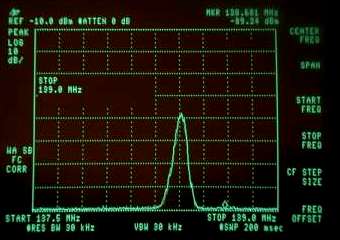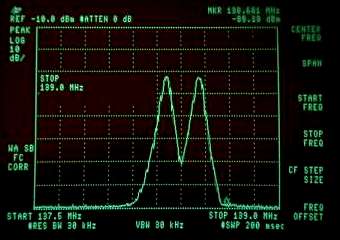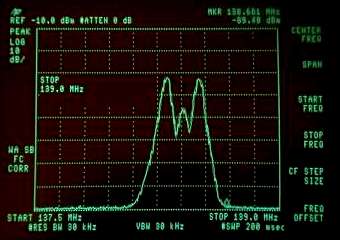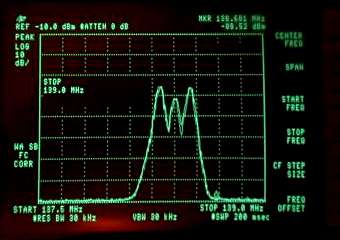|
| |
A New Antenna
So the next problem came when I upgraded from a QHA in the loft to an outside
turnstile (being unable to afford a professional QHA for outside). The problems came
back with a vengeance! I needed help, and at that point I was able to borrow a
spectrum analyser ("This one takes hours to warm up and the frequency display is off,
so you can borrow that for as long as you want!" [sorry, Dave]) to diagnose the
problem. What I found horrified me, not one signal, not two signals, but three page
signals all within about 500KHz of the satellite band! being a radio amateur, I live
in a very good VHF location, but so do all the local pager transmitters! I've shown
that using two different antennas produces different relative levels for the differing
interfering signals. (Remember the frequency calibration is off in these shots, the
two large signals are at 137.975 and 138.175 MHz. There is a list
of pager frequencies available on the Internet).

Not one interfering signal....
|

nor two other signals...
|

but three all at the same time! The first three shots on the outside
turnstile antenna.
|

You get different amplitudes with a loft-mounted QHA than with the outdoor
turnstile
|
Can we reject the interference?
A filter to reject interference that's only 500KHz away from 137MHz has to have
a very good performance, which results in large and expensive cavity filters. Even
then, you can usually get just a narrow passband and a narrow stop-band, at least that's
what I've seen with cavity filters for amateur radio repeaters. Here we want both a
good flat passband response, with a quite wide stopband to kill all three pager signals.
As hinted above, we should actually perhaps be trying to solve a different problem,
i.e. to make the receiver perform well in the presence of these huge signals. To put
this into perspective, the satellite signals are expected to be around -100 to -105 dBm
(anyone agree or disagree with this?), but the interference is around -30 dBm (two signals
at -32 dBm). So the interference is 10,000,000 times the power (3,000 times the
voltage) of the wanted signal. The clue to this was how well the 2m filter did in
improving the situation. It hardly rejected the interference by more than a dB or
so, but it worked because the problems were coming from receiver non-linearities
caused by the great strength of the interference.
Next - modifying the RX2 to
handle these levels
|